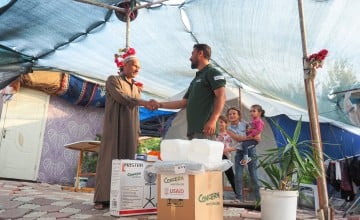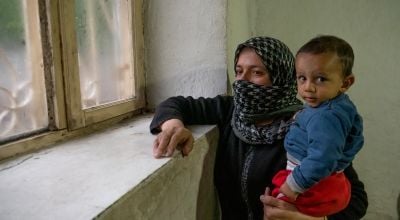
Read our 2023 annual report

Knowledge Hub
What does it mean to be a humanitarian? And why is humanitarian aid important? Here, we break down the what, who, where, when, why, and how of the work we do.
Concern is dedicated to creating a world where no one lives in poverty, fear, or oppression. Broadly speaking, our work falls into one of two categories: humanitarian aid and development. Those terms may sound interchangeable, but they each serve specific purposes. (Many nonprofit organisations and NGOs will focus on just one or the other; as a dual-mandate organisation, Concern does both.)
In this explainer, we look at what humanitarian aid means, why it's important, and the specific guidelines that hold all humanitarian work to the highest standard.
Humanitarian aid is for emergencies
Humanitarian aid is used to relieve suffering during emergency situations (such as conflict, an earthquake, or a drought). Development aid goes to addressing ongoing issues that contribute to human suffering.
Humanitarian aid usually directly goes to people. It’s the emergency supply kits that are distributed to people displaced by a hurricane. It’s the care offered by health workers as they screen and treat children for malnutrition while they live in a refugee camp. It’s the cash transfers offered to people displaced by war. By contrast, development aid is often used to improve structures and systems that in turn benefit entire communities (such as educational training and support in underserved areas).
Sometimes, the priorities for humanitarian and development aid can complement one another: Following Cyclone Freddy in Malawi, Concern distributed frontline necessities like NFI kits and cash transfers to those who lost homes and livelihoods in the floods. However, we also do ongoing development work in the country that fosters climate resilience through initiatives like disaster risk reduction. Development aid can help fund some of these programmes as they work towards long-term solutions that benefit communities at scale, but these initiatives also help participants to be better prepared for the next natural disaster.

Everyone has the right to receive humanitarian aid
Everyone has the right to receive humanitarian aid if they need it, regardless of their race, class, politics, ethnicity, gender, or any other identifying factors. Humanitarian emergencies tend to hit hardest for those furthest behind, but they also don't discriminate. In Syria, for example, families who lived comfortable, middle-class lives, lost everything either through escaping one of the worst humanitarian crises today, or while still living in their home country as infrastructure and resources have disappeared.
Without humanitarian aid, many families, communities, and even entire countries may fall deep into a cycle of poverty that carries a number of domino effects that can last for generations. Humanitarian aid offsets the immediate effects of a crisis to reduce this greater risk.

The humanitarian imperative comes first
There are a lot of stories (past and present) of humanitarians who go into countries and end up doing more harm than good. However, as much coverage as these stories can get, they don’t represent the humanitarian community by and large.
In fact, humanitarian aid has a number of codes and policies that organisations like Concern adhere to. It helps to ensure that our priorities are in the right place, and it helps multiple organisations (big and small, local and international) to work together towards a common cause with a shared standard.
The golden rule for humanitarians is what’s known as the Humanitarian Imperative. The International Red Cross and Red Crescent’s code of conduct defines the Humanitarian Imperative (in part) as: “The right to receive humanitarian assistance, and to offer it… wherever it is needed.”
At Concern, we complement this with a focus on maintaining dignity during and in the aftermath of disasters, and strengthening community preparedness for future disasters.

The four principles of humanitarian aid
There are several other guidelines for humanitarian aid, including the United Nations’ four principles. These play another key part in guiding our work:
1. Humanity
The principle of humanity means that we must seek to address human suffering wherever it is found, paying particular attention to those who are most vulnerable.
2. Impartiality
Our responses must be provided solely on the basis of identified need, without discrimination between or within affected populations. This is the basis of all “needs-based” programming. It requires us to assess the impact of disasters and to design programmes to support those left most in need in their wake.
3. Neutrality
We must ensure that our responses don’t favour any side in a conflict, or engage at any time in any political, racial, religious, or ideological controversies. This is perhaps the most challenging of these four principles.
4. Independence
The sole purpose of humanitarian activities and assistance is the relief and prevention of suffering caused by a crisis. This means we must respond in a manner that is not influenced by political, economic, or military objectives. Humanitarian organisations create and implement policies independent of government policies or actions (hence the term NGO, or “non-governmental organisation”).

When a crisis becomes a humanitarian crisis — and when they become even more complex
The traditional definition for a humanitarian crisis is an event (or series of events) that threatens the health, safety, and well-being of a community or large group of people. This can be specific to one group (such as the Rohingya crisis), or to anyone living in a certain area or country (such as the ongoing South Sudan crisis). In these cases, the basic approach to humanitarian aid has been to focus on the most pressing needs in the immediate aftermath, while also working to offset risk from future disasters.
Over the past few decades, however, emergencies have become more protracted and therefore harder to address. The longer an emergency lasts, the more complex it can become. In some cases, government services also break down and are unable to meet demand. We call these situations complex emergencies.
Complex emergencies mean humanitarian organisations are missing their most important partner, and people often can’t access the help they need to recover. Organisations also have to dig deeper to find what and where the needs are, and often struggle to find willing funders as crises drag on. Sadly, this is becoming the norm rather than the exception.

The rules are straightforward, but it makes the work that much more complicated
Consider this hypothetical situation: You run a Concern programme office in a country that has been plagued by years of conflict and political instability. Amid this, a 7.5-magnitude earthquake hits one part of the country.
Working with community members in a transparent manner, you’ve determined which groups in the region need the most help. One is a minority group in a hard-to-access part of the state controlled by a governing group that was spared the worst of the earthquake’s damage. However, the group leaders will only let you access the hard-to-reach area if you also give them some of the rations you are going to bring to those most-affected.
This arrangement would violate the UN’s Humanitarian Principles. But to ignore the group in most need also means going against the Humanitarian Imperative. What do you do?
Humanitarian aid workers face these problems every day, and they make an already-challenging job much more difficult to navigate. In a situation like the above, that may even mean being prepared to pull out of the area altogether if you cannot access the hard-to-reach group while preserving the integrity of the relief work and maintaining impartiality.
This is why so much training is required for humanitarian aid workers to ensure that they are well-equipped to navigate these challenges — challenges that can have life-or-death consequences for both the most vulnerable communities and the humanitarian aid workers themselves. (And that’s also why we run three distinct humanitarian training programmes.)
Concern’s humanitarian and emergency response
Emergency response is part of Concern’s DNA. Last year alone, Concern responded to 66 emergencies in 20 countries, reaching 15.5 million people. In each context our goal remains the same: fulfil our humanitarian mandate.
When an emergency strikes, we seek out the most vulnerable and hardest-to-reach communities to meet their immediate needs, and work with them to design innovative, fast and effective responses. We stay with them to help rebuild their lives and to ensure that they are better able to cope with future crises. Your support allows us to do this vital work.




